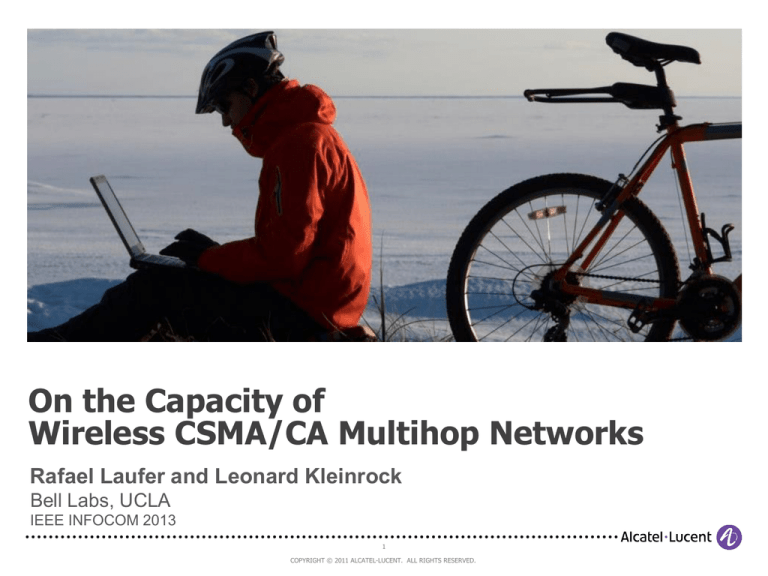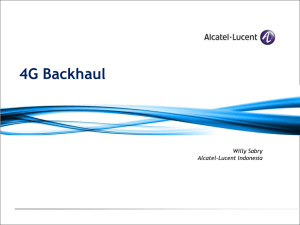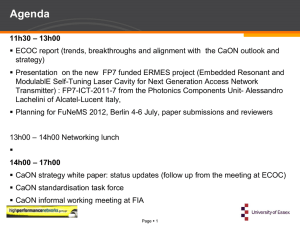
On the Capacity of
Wireless CSMA/CA Multihop Networks
Rafael Laufer and Leonard Kleinrock
Bell Labs, UCLA
IEEE INFOCOM 2013
1
COPYRIGHT © 2011 ALCATEL-LUCENT. ALL RIGHTS RESERVED.
INTRODUCTION
Wireless CSMA/CA Multihop Networks
• Carrier sense multiple access with collision avoidance (CSMA/CA)
- Before transmitting, the node verifies if the medium is idle via carrier sensing
- If idle, sample a random back-off interval and starts counting down
- Whenever busy, freeze the counter and wait for ongoing transmission to finish
1
2
3
U2(t)
1
1
t
2
COPYRIGHT © 2011 ALCATEL-LUCENT. ALL RIGHTS RESERVED.
INTRODUCTION
Wireless CSMA/CA Multihop Networks
• Considered unpredictable with unknown throughput limitations
- Distributed nature of CSMA/CA: nodes should back off from each other
- Buffer dynamics of unsaturated sources: time-varying subset of transmitters
- Dependence of downstream links on upstream traffic: coupled queue state
• Strong dependence among the state of transmitters
- Physical proximity and traffic pattern induce correlation across the network
3
COPYRIGHT © 2011 ALCATEL-LUCENT. ALL RIGHTS RESERVED.
INTRODUCTION
Goals
• Understand throughput limits of wireless CSMA/CA multihop networks
• Provide answers to specific questions regarding the network capacity
- If the rate of f1 increases by 10%, how much can f2 still achieve?
- If f3 starts, by how much must f1 and f2 slow down to keep the network stable?
• Determine the capacity region of arbitrary wireless networks
f2
f3
f1
4
COPYRIGHT © 2011 ALCATEL-LUCENT. ALL RIGHTS RESERVED.
INTRODUCTION
Key Contributions
• Theory to model the behavior of wireless CSMA/CA multihop networks
- Handle buffer dynamics of unsaturated traffic sources and multihop flows
- Respect interference constraints imposed by the wireless medium
• Characterization of the capacity region of any wireless network
- No restrictions on node placement: suitable for arbitrary networks
- Agnostic to the distribution of network parameters: only averages are relevant
- Convex only when nodes are within range: nonconvex in general
• Feasibility test
5
COPYRIGHT © 2011 ALCATEL-LUCENT. ALL RIGHTS RESERVED.
MODEL AND ASSUMPTIONS
System Model
• Single-path routing, with routes and bit rates assumed fixed
• Omnidirectional antenna communicating in a single channel
• CSMA/CA for medium access control
• Network state S composed of links transmitting
- Knowledge of the feasible link sets in the network
•
: fraction of time that all links in S are transmitting
6
COPYRIGHT © 2011 ALCATEL-LUCENT. ALL RIGHTS RESERVED.
THROUGHPUT MODELING
7
COPYRIGHT © 2011 ALCATEL-LUCENT. ALL RIGHTS RESERVED.
SATURATED SINGLE-HOP FLOWS
All Nodes Within Carrier Sense Range
8
COPYRIGHT © 2011 ALCATEL-LUCENT. ALL RIGHTS RESERVED.
SATURATED SINGLE-HOP FLOWS
All Nodes Within Carrier Sense Range
U1(t)
1
t
U2(t)
t
U3(t)
t
9
COPYRIGHT © 2011 ALCATEL-LUCENT. ALL RIGHTS RESERVED.
SATURATED SINGLE-HOP FLOWS
All Nodes Within Carrier Sense Range
• By definition, the steady-state solution is
• Ratio between
and
10
COPYRIGHT © 2011 ALCATEL-LUCENT. ALL RIGHTS RESERVED.
SATURATED SINGLE-HOP FLOWS
All Nodes Within Carrier Sense Range
• System of linear equations
• Steady-state solution
• Throughput of each flow
11
COPYRIGHT © 2011 ALCATEL-LUCENT. ALL RIGHTS RESERVED.
SATURATED SINGLE-HOP FLOWS
Not All Nodes Within Carrier Sense Range
1
3
2
12
COPYRIGHT © 2011 ALCATEL-LUCENT. ALL RIGHTS RESERVED.
SATURATED SINGLE-HOP FLOWS
Not All Nodes Within Carrier Sense Range
U1(t)
t
U2(t)
t
U3(t)
t
13
COPYRIGHT © 2011 ALCATEL-LUCENT. ALL RIGHTS RESERVED.
SATURATED SINGLE-HOP FLOWS
Not All Nodes Within Carrier Sense Range
• Steady-state solution for this case
• General solution
• Throughput of each flow
14
COPYRIGHT © 2011 ALCATEL-LUCENT. ALL RIGHTS RESERVED.
UNSATURATED SINGLE-HOP FLOWS
Idle Time
U1(t)
1
t
U2(t)
t
U3(t)
t
15
COPYRIGHT © 2011 ALCATEL-LUCENT. ALL RIGHTS RESERVED.
UNSATURATED SINGLE-HOP FLOWS
• Steady-state solution
• Source behavior
- Injecting too little traffic:
- Injecting too much traffic:
0
1
16
COPYRIGHT © 2011 ALCATEL-LUCENT. ALL RIGHTS RESERVED.
UNSATURATED SINGLE-HOP FLOWS
• Why the solution is similar to the saturated case?
• Statistically equivalent to a saturated network
- Average transmission times are the same
- Average backoff times are larger by 1/
17
COPYRIGHT © 2011 ALCATEL-LUCENT. ALL RIGHTS RESERVED.
UNSATURATED SINGLE-HOP FLOWS
Primal Unsaturated Network
U1(t)
1
t
U2(t)
t
U3(t)
t
18
COPYRIGHT © 2011 ALCATEL-LUCENT. ALL RIGHTS RESERVED.
UNSATURATED SINGLE-HOP FLOWS
Dual Saturated Network
U1(t)
1
t
U2(t)
t
U3(t)
t
19
COPYRIGHT © 2011 ALCATEL-LUCENT. ALL RIGHTS RESERVED.
CAPACITY REGION CHARACTERIZATION
20
COPYRIGHT © 2011 ALCATEL-LUCENT. ALL RIGHTS RESERVED.
CAPACITY REGION
Characterization Algorithm
• Normalized throughput of transmitter i
• Express
as a function of
• Find the inverse
• Limit the stability factors to the range
21
COPYRIGHT © 2011 ALCATEL-LUCENT. ALL RIGHTS RESERVED.
CAPACITY REGION
Two Transmitters Within Carrier Sense Range
22
COPYRIGHT © 2011 ALCATEL-LUCENT. ALL RIGHTS RESERVED.
CAPACITY REGION
Two Transmitters Within Carrier Sense Range
y1
1
y2
2
12
1
y1
1
1 1
1 1
1
1 1 2
y1
2 0
1
1 1
1
y2
2 1
1 0
2
2
1 1 2
12
23
COPYRIGHT © 2011 ALCATEL-LUCENT. ALL RIGHTS RESERVED.
1
y2
CAPACITY REGION
Three Transmitters Within Carrier Sense Range
24
COPYRIGHT © 2011 ALCATEL-LUCENT. ALL RIGHTS RESERVED.
CAPACITY REGION
Three Transmitters Within Carrier Sense Range
y1
1
1
y3
1
25
COPYRIGHT © 2011 ALCATEL-LUCENT. ALL RIGHTS RESERVED.
y2
CAPACITY REGION
Three Transmitters Not Within Carrier Sense Range
1
3
2
26
COPYRIGHT © 2011 ALCATEL-LUCENT. ALL RIGHTS RESERVED.
CAPACITY REGION
Three Transmitters Not Within Carrier Sense Range
y1
1
1
2
y 2 1 y 2
1
2
1 y 1 y 2
1
1 1 1 1 1
Capacity lost due to the lack of
synchronization between nodes
1 1 2 1 1 1
y1
2
2
1 1 2 1 1 1
12
1
1 1
27
COPYRIGHT © 2011 ALCATEL-LUCENT. ALL RIGHTS RESERVED.
1
1
y2
y2
CAPACITY REGION
Three Transmitters Not Within Carrier Sense Range
y1
1
1
y3
1
28
COPYRIGHT © 2011 ALCATEL-LUCENT. ALL RIGHTS RESERVED.
y2
FEASIBILITY TEST
29
COPYRIGHT © 2011 ALCATEL-LUCENT. ALL RIGHTS RESERVED.
FEASIBILITY TEST
Feasibility of Input Rates
• Does the network support a given rate vector
• Normalized throughput
-
depends only on average values
approximates the total transmission time as
approximates the total time as
• Plug into the expression
and check if
30
COPYRIGHT © 2011 ALCATEL-LUCENT. ALL RIGHTS RESERVED.
?
SIMULATION RESULTS
31
COPYRIGHT © 2011 ALCATEL-LUCENT. ALL RIGHTS RESERVED.
SIMULATION SCENARIO
MIT Roofnet Network: Single-Hop Flows
32
COPYRIGHT © 2011 ALCATEL-LUCENT. ALL RIGHTS RESERVED.
SIMULATION RESULTS
Single-Hop Flows (ρ = 1.00)
33
COPYRIGHT © 2011 ALCATEL-LUCENT. ALL RIGHTS RESERVED.
SIMULATION RESULTS
Single-Hop Flows (ρ = 0.50)
34
COPYRIGHT © 2011 ALCATEL-LUCENT. ALL RIGHTS RESERVED.
SIMULATION RESULTS
Single-Hop Flows (ρ = 0.25)
35
COPYRIGHT © 2011 ALCATEL-LUCENT. ALL RIGHTS RESERVED.
SIMULATION RESULTS
Single-Hop Flows (ρ = 0.01)
36
COPYRIGHT © 2011 ALCATEL-LUCENT. ALL RIGHTS RESERVED.
CONCLUSIONS
• Capacity of wireless CSMA/CA multihop networks poorly understood
• Theory able to model the network behavior
- Buffer dynamics of unsaturated sources and multihop flows
- Wireless CSMA/CA multihop networks are not erratic, but predictable
• System of nonlinear equations characterizes the network capacity
- Agnostic to the distribution of network parameters, only averages relevant
• Knowledge of the underlying process governing CSMA/CA networks
- Opens up new areas of research
- Routing optimization and network provisioning
37
COPYRIGHT © 2011 ALCATEL-LUCENT. ALL RIGHTS RESERVED.
On the Capacity of
Wireless CSMA/CA Multihop Networks
Rafael Laufer and Leonard Kleinrock
Bell Labs, UCLA
IEEE INFOCOM 2013
38
COPYRIGHT © 2011 ALCATEL-LUCENT. ALL RIGHTS RESERVED.








